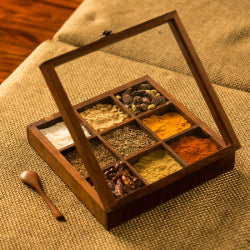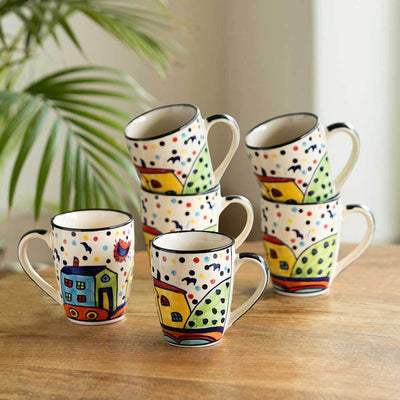Indian Tribal and Folk Art Forms You Need to Know
With over 2,500 tribes and regional groupings, India's cultural richness is reflected in the diverse forms of art created by the nation's native population. These old art forms have witnessed transformations over time. Acrylics and inks have substituted natural dyes and dyes, and traditional artworks, which were mostly used to decorate home surfaces, are now depicted on canvasses. Regardless, ethnic and tribal art today provides a window into India's rich history. Here are five such art forms that you should be aware of!
When interior decorations and handcrafted goods are loaded with heaps of originality, expertise, and modernism, it's showering beauty and charisma. The aesthetic excellence of Indian traditional art, handicraft and crafted items for home décor determine their rarity. The ornamental elements are the true decorations of your home, as they provide elegance to the overall image of any home. These small trinkets play an important function in enhancing and adorning your living area. These luxury handmade decoration items are truly needed to bring a touch of wholeness to your design, whether it's traditional, futuristic, or cultural. These Indian decorative pieces can enhance the appeal of your home. Believe us, you won't have to explore flea markets or stroll through malls all over the world to find the most unique and one-of-a-kind handicrafts online in their purest forms. Start browsing through our website. ExclusiveLane has the greatest handmade Indian folk art crafts.
Some Indian Traditional Tribal and Folk art forms-
MADHUBANI
Madhubani or Mithila paintings is an Indian form of art produced by women from the Mithila northern districts of Bihar. It is renowned for its elaborate patterns and brilliant colours. Madhubani paintings remained relatively unknown for centuries and were only "discovered" in 1934 when a British colonial inspector came across them on the walls of the house during a seismic survey. Natural colourants like turmeric, charcoal, cow manure, blues, wheat powder, sandalwood, and rose are still used in these paintings, which are created with fingertips, branches, paintbrushes, nib-pens, and matchsticks. The artists attempt to cover every area of the canvas with motifs, filling in the spaces with florals, animals, birds, and geometrical patterns, which is an intriguing element of this art style.
BHIL
The Bhils are among India's largest tribes, with roots in the Mahabharata's renowned archer Ekalavya. They live in Madhya Pradesh, Gujarat, Rajasthan, and Maharashtra.
Bhil art uses brilliant colours to depict tribal life. Everything associated with their lives is painted, representing changing of the seasons and also natural occurrences - the Sun, the Moon, the animals, plants, river, mythological figures, and their Gods. There's little debate that Bhil art portrays the tribe's intrinsic sense of aesthetics, whether it's on parchment or on the exterior of their homes. Herbal and vegetable colours, such as kumkum, turmeric, kajal, grain, Mehendi, limestone, and also acrylic paints, are used by Bhil artists.
MINIATURE PAINTINGS
These paintings are distinguished by their small size, exquisite detailing, and sharp expressions. Miniature paintings were popular throughout the Mughal Empire, around the 16th century, and were influenced by Persian forms. They flourished during the reigns of Shah Jahan and Akbar. Rajputs then embraced it, and it is currently widely practised throughout Rajasthan. The paintings, like other art genres, portray spiritual motifs and sagas. Humans are depicted with wide eyes, a sharp nose, and a thin waist in these paintings, and gentlemen are always wearing a turban.

WARLI
This is easily one of India's oldest art styles, having been created by the Warli tribes of the Western Ghat in 2500 BCE. It mostly consists of the use of circles, triangles, and squares to create a variety of shapes and reflect everyday activities like fishing, hunting, festivities, dancing, and so on. The humanoid shape, which consists of a circle and 2 triangles, distinguishes it. The shapes are white, and the paintings are all done on a vermilion or black background.
GOND
The Gondi tribe of Madhya Pradesh developed these bright, vibrantly coloured paintings, mostly representing flora and fauna, as part of their feeling of belonging to nature. Charcoal, cow dung, leaves, and coloured dirt are used to create the colours. It's composed of dots and strokes if you look attentively. These styles are still imitated today, but with tempera paint. It can be described as development in Gond art, led by Jangarh Singh Shyam, the best Gond artist, who resurrected the art style for the world in the 1960s.

KALAMKARI
Kalamkari, which literally means "pen drawings," is categorized into two kinds in India: Machilipatnam, which comes from Machilipatnam in Andhra, and Srikalahasti, which comes from Chittoor in the very same state. The former is a block-printed kind of art, and the latter is a free-flowing art on cloth created with a pen. Kalamkari art may now be found on sarees and traditional clothes, depicting anything from plants and animals to classics like the Mahabharata and Ramayana.
India has a diverse cultural legacy, which is complemented by a wide range of folk arts and tribal arts of India. These different types of folk art in Indian styles represent the country's many civilizations, but each one is distinct and distinct from the others. Every state does have its own folk form of art, which are all stunning and wonderful. However, these creative traditional folk art of Indi forms were on the wane a few years ago, but they are now thriving because of a renewed interest in local artists.
ExclusiveLane, an Indian handicraft store, on the other hand, assures that your appetite is satisfied with the rarest handmade assortment. The largest assortment of products leads to a wealth of online possibilities that will save you time and effort as you scour the market. With a range of traditional painting styles of India that covers every concept in its unique shape, give your home an unpredictable European style, an exquisite Italian design, or a classic Indian look. The fantastic deals and offers, as well as the simple return policy, allow you to just get your paws on whatever you've ever wanted.









Very Well Written about thanks for sharing such useful
you can check out our website for an online course on such information
https://online.penkraft.in/OnlineCourseDetail/PattachitraArt
Great blog, thank you for the information
Amazing article I must say. Every art form is so well explained. Overall the article is very informative.
Leave a comment